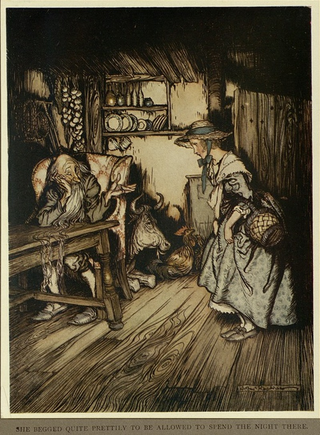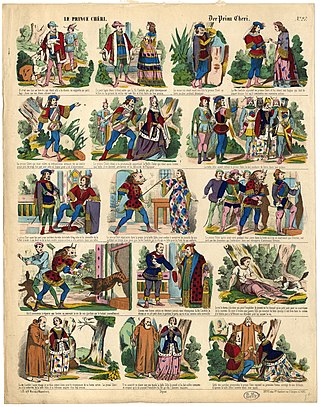
"Beauty and the Beast" is a fairy-tale written by French novelist Gabrielle-Suzanne Barbot de Villeneuve and published in 1740 in La Jeune Américaine et les contes marins.

The Frog Princess is a fairy tale that has multiple versions with various origins. It is classified as type 402, the animal bride, in the Aarne–Thompson index. Another tale of this type is the Norwegian Doll i' the Grass. Eastern European variants include the Frog Princess or Tsarevna Frog and also Vasilisa the Wise ; Alexander Afanasyev collected variants in his Narodnye russkie skazki, a collection which included folk tales from Ukraine and Belarus alongside Russian tales.

"The Black Bull of Norroway" is a fairy tale from Scotland. A version titled "The Black Bull of Norroway" in the 1870 edition of Popular Rhymes of Scotland was reprinted in an Anglicised version by Joseph Jacobs in his 1894 book More English Fairy Tales.

The Wonderful Birch is a Finnish/Russian fairy tale. A variant on Cinderella, it is Aarne–Thompson folktale type 510A, the persecuted heroine. It makes use of shapeshifting motifs. Andrew Lang included it in The Red Fairy Book.

"The Singing, Springing Lark", "The Singing, Soaring Lark", "The Lady and the Lion" or "Lily and the Lion" is a German fairy tale collected by the Brothers Grimm, appearing as tale no. 88.
The Giant Who Had No Heart in His Body is a Norwegian fairy tale collected by Asbjørnsen and Moe.

The Death of Koschei the Deathless or Marya Morevna is a Russian fairy tale collected by Alexander Afanasyev in Narodnye russkie skazki and included by Andrew Lang in The Red Fairy Book. The character Koschei is an evil immortal man who menaces young women with his magic.
The Brown Bear of Norway is an Irish fairy tale collected by Patrick Kennedy which appeared in his Legendary Fictions of the Irish Celts (1866). It was later included by Andrew Lang in his anthology The Lilac Fairy Book (1910), though Lang misattributed his source as West Highland Tales.

"The Blue Bird" is a French literary fairy tale by Madame d'Aulnoy, published in 1697. An English translation was included in The Green Fairy Book, 1892, collected by Andrew Lang.

The youngest son is a stock character in fairy tales, where he features as the hero. He is usually the third son, but sometimes there are more brothers, and sometimes he has only one; usually, they have no sisters.

"The Hut in the Forest" is a German fairy tale collected by the Brothers Grimm. Andrew Lang included it in The Pink Fairy Book (1897). It is Aarne-Thompson type 431.

The Enchanted Pig is a Romanian fairy tale, collected in Rumanische Märchen and also by Petre Ispirescu in Legende sau basmele românilor. Andrew Lang included it in The Red Fairy Book.
The Tale of the Hoodie is a Scottish fairy tale, collected by John Francis Campbell in his Popular Tales of the West Highlands. Andrew Lang included it, as The Hoodie-Crow, in The Lilac Fairy Book.
The Gold-bearded Man is a Hungarian fairy tale collected by Laszlo Arany. It was translated and published as Der goldbärtige Mann by Elisabeth Rona-Sklárek in Ungarische Volksmährchen. Andrew Lang included it in The Crimson Fairy Book.
The Sprig of Rosemary is a Catalan fairy tale from Spain collected by Dr. D. Francisco de S. Maspons y Labros in Cuentos Populars Catalans. Andrew Lang included it in The Pink Fairy Book.
King Kojata or The Unlooked for Prince or Prince Unexpected is a Slavonic fairy tale, of Polish origin. Louis Léger remarked that its source was "one of the most important collections of Polish literature".

The Sea-Maiden is a Scottish fairy tale collected by John Francis Campbell in Popular Tales of the West Highlands, listing his informant as John Mackenzie, fisherman, near Inverary. Joseph Jacobs included it in Celtic Fairy Tales.
The Prince Who Wanted to See the World is a Portuguese fairy tale, collected first by Portuguese writer Theophilo Braga. Andrew Lang included it in The Violet Fairy Book.
The Three Daughters of King O'Hara is an Irish fairy tale collected by Jeremiah Curtin in Myths and Folk-lore of Ireland. Reidar Th. Christiansen identified its origin as County Kerry.

Prince Darling is a French literary fairy tale written by Madame Jeanne-Marie Leprince de Beaumont.













